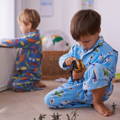Alone Together: What Is Parallel Play and Why It Matters?
The parallel play stage in toddlers’ lives is when they play next to other children but not necessarily with them. They will spend time in the same room and sit right next to each other, yet, they most likely won’t communicate amongst themselves. They are seemingly not focused on each other but play parallel to each other, hence the name - parallel play.
Many first-time parents worry at the sight of their child “not socializing” with their peers, but parallel play is the exact opposite - it’s one of the first steps in developing social skills.
You can observe this behavior at playdates, preschool classrooms, or birthday parties. You will see your toddler having the best of times playing all alone, right next to three or four other children.
However, if you take a closer look, you will see that your child is also watching what other children are doing and is sometimes copying their actions. That is how children progress as they build up their social maturity.
Think of yourself when you go to a gathering and don’t know anyone there. Most people take out their phones and stare at them until they feel a little more comfortable talking to others.
Dr. Mildred Parten Newhall was the one who defined the parallel play stage. She stated that it is one of the six stages of a child’s play that happen throughout the child's development. Let’s dive into them.
Mildred Parten's Social Behavior Theory and the 6 Stages of Play
Dr. Parten conducted one of the first studies about children’s preschool playtime behaviors. She observed how children behave during joint playtime and concluded that there is a correlation between the types of children’s group play and their social skill advancement and even language development.
Simply put, as children get older and improve their communication skills, they spend less time playing independently and more with their peers.
The six stages of child’s play, according to Dr. Parten, are as follows:
Stage 1: Unoccupied Play
This is the first phase of a child’s play journey. It happens in the first few months of infancy. The play is scattered and goalless. Babies learn about the world around them, wave their hands and feet, explore their surroundings, or enjoy their pulling toy.
You see it when they point to their mobile or a ceiling or during their tummy time. Through this period, babies develop their gross motor skills, become aware of their bodies, and enjoy sensory experiences.

Stage 2: Solitary Play
This type of play begins as early as three months old. Babies haven’t learned to socialize yet, and the only entertainment they can find is themselves. They will explore and play with their toys without interacting with adults or other children.
This is the period of discovery and learning about their surroundings. They will crawl around and look for new things to experience. As they get older, this type of play will become more focused and will lead to and happen simultaneously as the next stages of play development.

Stage 3: Onlooker Play
Sometimes you’ll see your toddler sitting on the side, watching other kids play. You might wonder if they feel lonely or are afraid of the group. That’s not the case. This is the phase when they simply observe children and their social interactions. Children learn immensely from those experiences.
They learn social skills and play skills. More precisely, they discover how other kids interact with each other, how they play with their toys or the rules of a particular game. Remember - your child is not missing out on anything by being an “onlooker” - they are simply “studying” other kids. It is an entirely normal and desirable part of their social development journey.

Stage 4: Parallel Play
This is when two or more children start playing side by side in the same area but with little to no communication. Dr. Parten calls this a parallel play. The parallel play is the fourth stage out of the six play stages she describes.
You can think of the parallel play as a sort of warm-up for future types of play. It is one of the developmental milestones, and there is nothing to worry about. We’ll get to why parallel play is important in early childhood development in a minute.
For now, just remember - it's all good. Your little one is enjoying themselves and opening up their own world to peer influences. They are just doing it carefully at this point.

Stage 5: Associative Play
This is when the most significant shift in children’s focus happens. It occurs between ages 3 and 5. Suddenly, instead of paying full attention to their toys or the game they're playing, kids are now becoming more interested in other children playing with them. The results of the parallel play quiet discovery phase are finally visible. It's time for the early phases of the group play.
At this point, the way the children play is not yet fully structured, and there is no common end goal. However, the important thing is that they are playing and learning together. They start talking to each other about what they’re doing or what they would like to do while playing. This all leads to the final stage of children’s play, which is:

Stage 6: Cooperative Play
Once children start to understand and follow game rules or find a common goal for their playtime, the phase of cooperative play begins. This can happen as early as age four. Children can now thoroughly socialize with their peers and construct play sessions together. They can build a snowman together, play hide-and-seek, or compete in problem-solving games like these Montessori toys for 5-year-olds.

What Is the Benefit of Parallel Play?
- The first step in socializing and making friends. After the onlooker, solitary, and parallel play phases have passed, it is time to play “with” other children. As toddlers this age are still building their social skills, playing next to them is the best way to introduce themselves to their new buddies.
- Learning from peers. Picking up on what other kids are doing and learning new stuff is the result of spending time next to other kids. It will make your toddler observe them and probably copy what they’re doing.
- Language and communication skills. Even though they’ll mostly play silently and by themselves, toddlers will eventually try to communicate with their playdate. Whether it's “Can I have that toy?” or “That’s mine!”, it’s a way to practice conveying thoughts and feelings to others. They’ll also learn a bunch of new words, no doubt.
- Sharing items and taking turns. This is a big one. We all teach kids not to be selfish, but this is something they have to learn for themselves. Parallel play is a great opportunity. If there are multiple toddlers and fewer toys on their playdate, they’re bound to share at some point. It’s the same with taking turns on a swing, for example. Overcoming this “obstacle” is a huge milestone in reaching social maturity.
- Social cues and boundaries. Spending time next to other kids and their parents will teach your toddler loads of stuff about their relationships. They’ll pick up on stuff other kids are allowed or not allowed to do or how they react to instructions. They’ll see how others behave or misbehave when it’s time to go home and other important skills.
- Gross and fine motor development. As they see other kids playing, your toddler will try to imitate them. Every new game, move, or play idea invites kids to expand their skill set. It could be a game with a ball, and your child will try to learn how to throw it.
At What Age Does Parallel Play Occur?
It can start as early as 18 months old. Every child is unique, and their development varies. You will probably see this once your toddler goes on a playdate or you have your friends and their kids over for dinner.
The important thing to remember during the play stage is not to worry about them not playing with each other - it’s just a phase in their development. Also, avoid trying to make them play together - kids know exactly how they feel and if they’re up to playing with their new friends.
When Does Parallel Play End?
The time when parallel play ends and associative one starts goes from two to three years of age. They can often overlap, however. This is the period of big social and emotional growth; your toddler will display it through interactions with other kids.
It is not uncommon to see your child enjoy solitary play as well. Whatever feels natural to your kid is best for them. Another philosophy that supports this view is the one following the Montessori method.
It argues that children should always take the lead in their play, and if they feel they should play alone, next to other kids, or with them, you should let children play with them. That’s how they build their independence.
What Is an Example of Parallel Play?
You might see two toddlers playing with dough right next to each other. They won’t talk to each other or share their play materials. However, the things they build might be quite similar. They are focused on their activities but also keep an eye on what other kids are doing and often copy them.
Another example would be young children playing with the same set of building blocks. Each would take a few pieces and play on their own, not even trying to build something with their playmates. Their social skills aren’t developed enough, so playing together would be a better option. They’re more interested in the materials they’re playing with than who they’re playing with.
Parallel vs. Solitary Play
They might seem quite similar, but they are separate stages of play. They both look as if a child is entirely focused on their own activity, not trying to interact with others.
However, while in solitary play, babies and infants are actually concentrated on the exploration and new experiences a toy or a game can give them. During parallel play, they know that the children around them observe their actions. Moreover, they often copy what they do.
Parallel play is the next step after the solitary stage. They can often overlap and happen during the same periods of child development too. It all depends on your toddler's needs and developmental pace. Discover what feels most comfortable to your child and allow them to express themselves in any kind of play they like.
How Can Adults Help with Parallel Play?
There are several ways adults can encourage children to enjoy their parallel play and create an environment in which they can hone their parallel play skills. If you want to support parallel play, here are some ideas on what you can do:
- Learn how to recognize the parallel play and how to discern solitary and parallel play.
- Stimulate your kid's curiosity and inspire them to develop their own ideas instead of insisting that they play within a group. Let the child play and develop at their own pace.
- Engage in parallel play activities. Show rather than tell how to play. Kids enjoy watching when their parents play and try doing the same.
- Teach turn-taking. Parallel play is an excellent opportunity to teach turn-taking and sharing if you have two or more children playing alongside.
- Organize playdates with parallel-aware play. If you have only one child, organizing playdates with other young toddlers and parents aware of the benefits of parallel play is a good idea.
- Don't force child plays. Allow two children to start playing with each other naturally without being prompted to do so. Child-initiated play will be much more rewarding and essential for their emotional development.
There’s a lot of stuff children do during their playtime that we, adults, find confusing. However, as long as how they play is safe and doesn’t infringe on other people’s boundaries, it’s OK. Following your child’s interests is always more beneficial than forcing them to do one thing or another.
The transition between parallel play and the next developmental stage in children’s playing should never be forced but can be gently inspired. Carefully pick your child's Montessori toys by age and help their parallel play become even more beneficial and engaging.
Free Delivery
Over $80
Easy Returns
No questions asked
Unbeatable Warranty
1-year ++ warranty
- Secure CheckoutWorld’s most secure payment method




